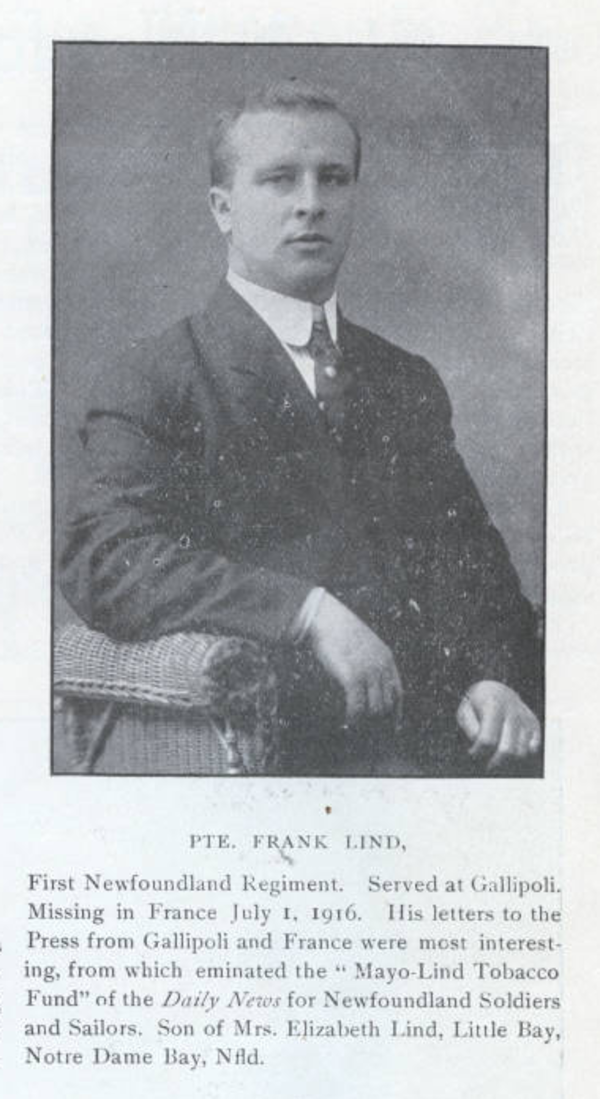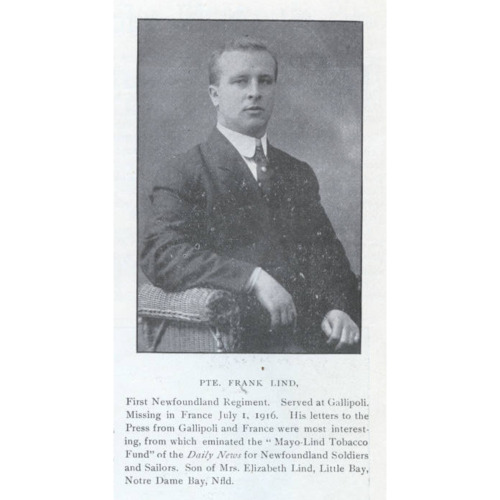
Source: Link
LIND, FRANCIS THOMAS, accountant and soldier; b. 9 March 1879 in Betts Cove, Nfld, youngest of the five sons of Henry Lind and Elizabeth Walker; d. unmarried 1 July 1916 near Beaumont-Hamel (Beaumont), France.
Frank Lind’s father was an outport schoolmaster and then a storekeeper with the Betts Cove Mining Company. In 1885 the family moved to Little Bay, where the company had made a new find of copper. Frank attended the local school until the age of 14, when he became a clerk with a merchant in Fogo. After his apprenticeship, he joined Ayre and Sons, St John’s largest retailer. He then worked successively for Rhodes, Curry and Company in Amherst, N.S., Ayre and Sons, and Earle and Sons in Fogo.
When World War I broke out in August 1914, the fair-haired, blue-eyed accountant answered the call despite the fact that he was considered past the prime age for recruits. He enlisted in the Newfoundland Regiment on 16 September in St John’s. As the recruits drilled on the outskirts, manufacturers rushed to provide uniforms, but, when they paraded through the city to embark, they were still without headgear and khaki for puttees. Instead, they were provided with knitted caps and navy blue puttees, which became a mark of distinction. After crossing to England in October, the Newfoundlanders trained at Pond Farm Camp on Salisbury Plain and, on 4 December, were transferred to Fort George, near Inverness in Scotland. Well liked, Lind was not averse to taking off for a day or more every few months.
On the 26th Lind dispatched the first of 32 letters that were to appear in the St John’s Daily News. It was typically good-natured and gossipy. He complained only that on entering Fort George his contingent had been “honoured” by a band playing the “Maple Leaf” – in Scotland as “everywhere in England we were taken as Canadians.” Lind’s letters were eagerly read at home. In his fourth, from Stobs Camp (53 miles from Edinburgh) on 20 May 1915, he complained about English tobacco. On its appearance in the News, the Imperial Tobacco Company Limited of St John’s (maker of Mayo brand cakes of tobacco and a major advertiser in the News) launched an appeal for donations to buy tobacco. In July 1,700 pounds of Mayo arrived at Stobs. Lind, who was already being teased for his age and studious nature, wrote: “It is needless to say I am now called Mayo Lind.”
After training in Egypt, his regiment was dispatched to the Dardanelles in September to reinforce the hard-hit 29th British Division. Hospitalized that winter, first for jaundice and then for frostbite in his feet, Lind rejoined his unit in March, in France, but suffered from influenza and continued problems with his right foot until the end of May. While north of the Somme River, the regiment received a second shipment of “Christmas Mayo-Linds,” which had been following them for more than six months.
In early June they began training in earnest for the Great Push. On the 15th Lind went into the front-line trenches near the German-held hamlet of Beaumont-Hamel. In his letter of the 29th – his last – he noted that at one point the Germans had held up a sign asking “When are the White Indians from Newfoundland coming over?”
The opening day of the battle of the Somme, 1 July 1916, found Lind and his comrades, among them Owen William Steele, in a trench known as St John’s Road. After most of the regiment went over the top in an attack marked by confusion and delay, they had to advance alone over 250 yards, including belts of barbed wire. With German machine-guns trained on the gaps, one observer noted, “they all instinctively tucked their chins into an advanced shoulder as they had so often done when fighting their way home against a blizzard.” As Lind’s company emerged from the wire, its commanding officer and Lind’s platoon lieutenant and sergeant fell. Those still mobile advanced toward a blasted apple tree known to the Newfoundlanders as the Danger Tree, where Lind is said to have fallen. The next day only 68 out of 778 Newfoundlanders answered the roll-call. In November the Lind family was still fearfully trying to confirm Frank’s death.
Lind’s remains were eventually found and identified, and in June 1917 Private F. T. Lind was buried in Y Ravine Cemetery at Beaumont-Hamel, in what later became the Newfoundland War Memorial Park. The Mayo-Lind Tobacco Fund continued for the duration of the war. Afterwards the publisher of the Daily News, John Alexander Robinson, produced a small volume of The letters of Mayo Lind “in memory of the cheerful soldier.”
The letters are of limited interest to military historians, but after Lind’s death he became a symbol in Newfoundland of the soldier who could face discomfort, and ultimately sacrifice, with good humour, a stand-in for all the other ranks who died at Beaumont-Hamel. In Newfoundland 1 July was celebrated as the national day of remembrance in 1917, and this celebration has continued, despite its coincidence with Canada’s national holiday.
The letters of Mayo Lind was published in St John’s in 1919.
Centre for Newfoundland Studies, Memorial Univ. of Nfld (St John’s), Arch., mf-147 (Owen Steele papers). J. R. Smallwood Centre for Newfoundland Studies (St John’s), Mayo Lind file. NA, RG 150, Acc. 1992–93/166, Royal Newfoundland Regiment, file 541. Richard Cramm, The first five hundred; being a historical sketch of the military operations of the Royal Newfoundland Regiment in Gallipoli and on the Western Front during the Great War (1914–1918) . . . (Albany, N.Y., [1921]). Encyclopedia of Nfld (Smallwood et al.). G. W. L. Nicholson, The fighting Newfoundlander: a history of the Royal Newfoundland Regiment (St John’s, [1964]). M. L. Taylor, Westward with Henry and Caroline (Grand Falls, Nfld, 1989).
Cite This Article
Robert H. Cuff, “LIND, FRANCIS THOMAS,” in Dictionary of Canadian Biography, vol. 14, University of Toronto/Université Laval, 2003–, accessed April 26, 2025, https://www.biographi.ca/en/bio/lind_francis_thomas_14E.html.
The citation above shows the format for footnotes and endnotes according to the Chicago manual of style (16th edition). Information to be used in other citation formats:
| Permalink: | https://www.biographi.ca/en/bio/lind_francis_thomas_14E.html |
| Author of Article: | Robert H. Cuff |
| Title of Article: | LIND, FRANCIS THOMAS |
| Publication Name: | Dictionary of Canadian Biography, vol. 14 |
| Publisher: | University of Toronto/Université Laval |
| Year of revision: | 1998 |
| Access Date: | April 26, 2025 |



